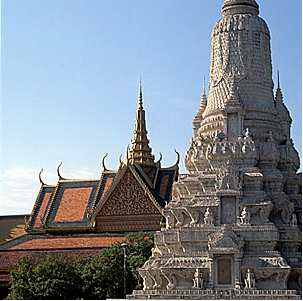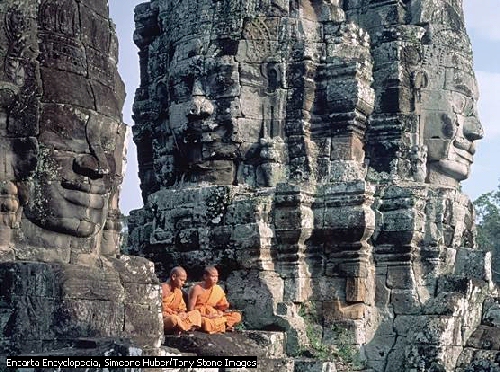


Republic of Vietnam...
Crossroad of Culture
By 1LT Samual B. Huff
UpTight Editor
Submitted by fellow Spur, Bill McCalister
It is easy to miss the cultural aspects of a combat zone, where bunkers, bullets and booby traps are of more immediate concern. Yet the Republic of Vietnam is culturally one of the unique areas of the world. Inhabited in ancient times by such exotic Indianized craftsmen as the Chams and Khmers, later dominated by the Chinese and finally colonized by the French, this land is truly the Asian crossroad of the arts.
Colonists from India created the first great kingdom in the region, stretching south and west from the Mekong Delta. By the eighth century it had evolved into the Khmer empire, whose once-lavish capital, Angkor, was recently uncovered beneath the jungles of eastern Cambodia.

Royal Palace at Phnom Penh
Courtesy of The Learning Company
Although relatively few Khmers still live in Vietnam, urban shops abound with replicas of their ancient bronze and stone sculpture. Most of these art objects depict gods and kings. Commonly represented in early works is a seven-headed serpent, a deity of Indian origin who supposedly guarded the waters to enable the people to cultivate their fields. Another recurring symbol is the four-faced head, an emblem of the king's devine power to survey in four directions at once.
Originally a Hindu people, the Khmers were eventually won over to Buddhism. Their descendants now form the bulk of the Cambodian population.

Bayon Temple, Angkor Thum
The giant faces carved on the Bayon temple at the Angkor Thum complex in northwestern
Cambodia represent both the Buddha and King Jayavarman VII (ruled about 1130-1219).
Although a Buddhist temple, Angkor Thum was modeled after the great Hindu temple complex of Angkor Wat
Encarta Encyclopedia Simeone Huber/Tony Stone Images
Microsoft® Encarta® Encyclopedia 2002. © 1993-2001 Microsoft Corporation. All rights reserved.
A second Indian colonization evolved into the Cham kingdom, which stretched along the seacoast from the Central Highlands into what is now North Vietnam. This society developed alongside that of the Khmers, but because its prosperity was thwarted by more powerful neighbors to the north, it was not as artistically prolific. Even so, Cham art has its own styles and peculiar beauties.
During their height of power, the Chams built many towers to honor their kings. The ruins of these structures can be seen today near Nha Trang, Phan Rang and in Binh Dinh Province. Their architecture features blind arches, pedestal altars and extensive relief work.
Beginning around the 12th century the forefathers of the modern Vietnamese, centered for centuries in the North under Chinese domination, gradually took over what is now South Vietnam, bringing with them their form of Buddhism with its wooden architecture of fundamentally Chinese inspiration. Faint echoes of the early Hindu style survived in the form of flamboyantly ornamented eaves and gables.
Because the materials used were not strong enough to survive the tropical monsoon climate, it is impossible to identify any true Vietnamese art which is earlier than the 19th century. The imperial palace at Hue, built around 1810, consists of a series of simple, one-story rectangular pavilions laid out inside a group of courts among trees. The inner buildings have a bright and airy simplicity which is characteristically Chinese.
The French colonization in 1868 brought still another influence to Vietnam. Although the French left in 1954, examples of their architecture dot the countryside and dominate large areas of the cities.
More significantly, the French left much in the way of religious and educational tradition, which in turn has shaped contemporary Vietnamese art.
One of the most astounding out-croppings of Western influence in the East is the Cao Dai religion. Founded in Saigon in 1922, it combines the teachings of. Confucius, Buddha and Jesus Christ and today has five million members. Its main temple, in Tay Ninh City, features such cultural curiosities as Greek columns embellished with Chinese dragons.
Another remnant of French colonization is widespread use of Western techniques by Vietnamese artists themselves. "Most of my teachers studied in Paris," said Nguyen Thanh Thu, a well known Vietnamese painter and sculptor who is now a fine arts advisor for Republic of Vietnam Armed Forces. He said he uses Western methods because they give him more freedom of expression.
Actually there are two main schools of painting and sculpture in Vietnam today. One is influenced by. the European Renaissance and modern French art and applies European techniques to traditional themes. The other gives an Oriental touch to works styled after the European masters.
Thu, who designs many of the nation's governmental monuments, said he is particularly interested in the style of American sculptors such as Marshall Fredericks. If his interest is typical, perhaps there will be yet another influence on this Asian cross-road of the arts.